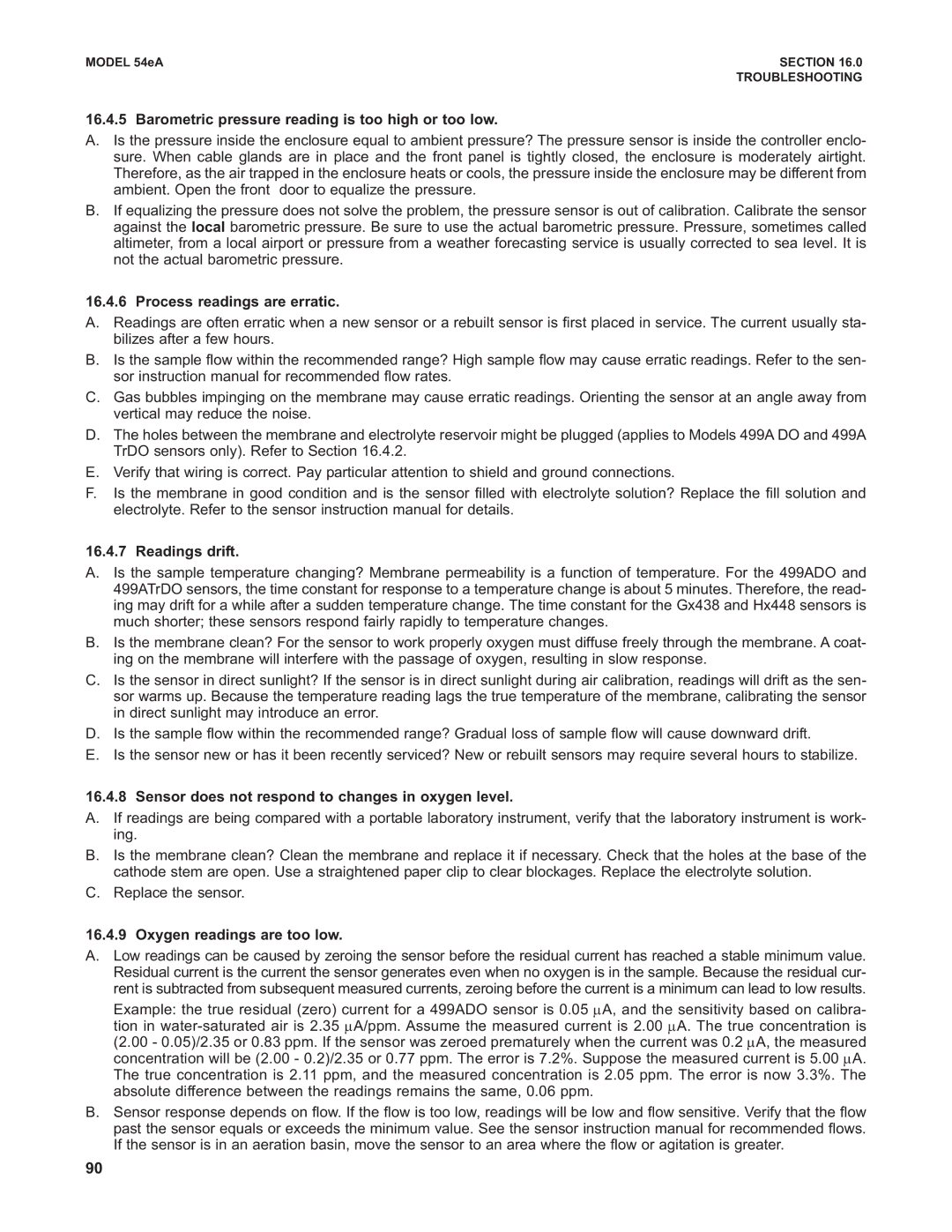MODEL 54eA | SECTION 16.0 |
| TROUBLESHOOTING |
16.4.5 Barometric pressure reading is too high or too low.
A.Is the pressure inside the enclosure equal to ambient pressure? The pressure sensor is inside the controller enclo- sure. When cable glands are in place and the front panel is tightly closed, the enclosure is moderately airtight. Therefore, as the air trapped in the enclosure heats or cools, the pressure inside the enclosure may be different from ambient. Open the front door to equalize the pressure.
B.If equalizing the pressure does not solve the problem, the pressure sensor is out of calibration. Calibrate the sensor against the local barometric pressure. Be sure to use the actual barometric pressure. Pressure, sometimes called altimeter, from a local airport or pressure from a weather forecasting service is usually corrected to sea level. It is not the actual barometric pressure.
16.4.6 Process readings are erratic.
A.Readings are often erratic when a new sensor or a rebuilt sensor is first placed in service. The current usually sta- bilizes after a few hours.
B.Is the sample flow within the recommended range? High sample flow may cause erratic readings. Refer to the sen- sor instruction manual for recommended flow rates.
C.Gas bubbles impinging on the membrane may cause erratic readings. Orienting the sensor at an angle away from vertical may reduce the noise.
D.The holes between the membrane and electrolyte reservoir might be plugged (applies to Models 499A DO and 499A TrDO sensors only). Refer to Section 16.4.2.
E.Verify that wiring is correct. Pay particular attention to shield and ground connections.
F.Is the membrane in good condition and is the sensor filled with electrolyte solution? Replace the fill solution and electrolyte. Refer to the sensor instruction manual for details.
16.4.7 Readings drift.
A.Is the sample temperature changing? Membrane permeability is a function of temperature. For the 499ADO and 499ATrDO sensors, the time constant for response to a temperature change is about 5 minutes. Therefore, the read- ing may drift for a while after a sudden temperature change. The time constant for the Gx438 and Hx448 sensors is much shorter; these sensors respond fairly rapidly to temperature changes.
B.Is the membrane clean? For the sensor to work properly oxygen must diffuse freely through the membrane. A coat- ing on the membrane will interfere with the passage of oxygen, resulting in slow response.
C.Is the sensor in direct sunlight? If the sensor is in direct sunlight during air calibration, readings will drift as the sen- sor warms up. Because the temperature reading lags the true temperature of the membrane, calibrating the sensor in direct sunlight may introduce an error.
D.Is the sample flow within the recommended range? Gradual loss of sample flow will cause downward drift.
E.Is the sensor new or has it been recently serviced? New or rebuilt sensors may require several hours to stabilize.
16.4.8 Sensor does not respond to changes in oxygen level.
A.If readings are being compared with a portable laboratory instrument, verify that the laboratory instrument is work- ing.
B.Is the membrane clean? Clean the membrane and replace it if necessary. Check that the holes at the base of the cathode stem are open. Use a straightened paper clip to clear blockages. Replace the electrolyte solution.
C.Replace the sensor.
16.4.9 Oxygen readings are too low.
A.Low readings can be caused by zeroing the sensor before the residual current has reached a stable minimum value. Residual current is the current the sensor generates even when no oxygen is in the sample. Because the residual cur- rent is subtracted from subsequent measured currents, zeroing before the current is a minimum can lead to low results.
Example: the true residual (zero) current for a 499ADO sensor is 0.05 μA, and the sensitivity based on calibra- tion in
B.Sensor response depends on flow. If the flow is too low, readings will be low and flow sensitive. Verify that the flow past the sensor equals or exceeds the minimum value. See the sensor instruction manual for recommended flows. If the sensor is in an aeration basin, move the sensor to an area where the flow or agitation is greater.
90
